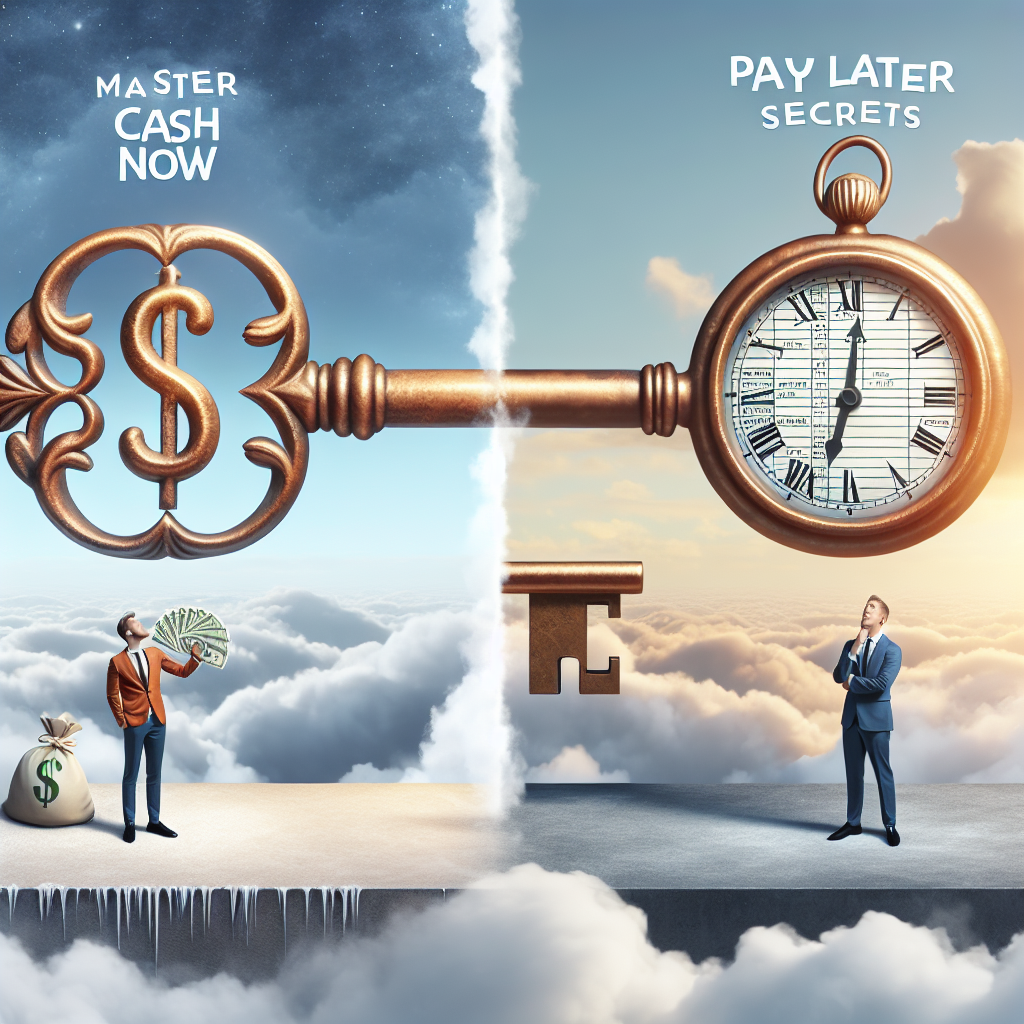Unlock Financial Freedom: Master Cash Now, Pay Later Secrets

“Access Funds Instantly, Enjoy Flexibility in Repayment with Cash Now, Pay Later.”
Cash Now Pay Later (CNPL) is a financial service that allows consumers to receive immediate funds or products with the agreement to repay the amount over a specified period of time. This service is similar to traditional loans or credit systems but is often tailored for quick approval and convenience, targeting short-term borrowing needs. CNPL solutions are typically used for unexpected expenses, emergency funds, or when consumers need to make purchases but do not have immediate access to the necessary funds. The repayment terms can vary, often including interest or fees, and are designed to fit the borrower’s cash flow. This model has gained popularity with the rise of fintech companies offering flexible and accessible financing options.
Get the funds you need today without the wait! Click here to apply for Cash Now Pay Later options and enjoy instant approval on personal loans. Don’t let financial constraints hold you back. Apply now!
Exploring the Benefits and Risks of Cash Now Pay Later Services
Cash Now Pay Later
In the ever-evolving landscape of financial services, the emergence of Cash Now Pay Later (CNPL) options has introduced a novel approach to managing personal cash flow. These services, which offer immediate access to cash with the agreement to repay the amount at a later date, have gained popularity for their convenience and the financial flexibility they provide. However, as with any financial product, it is crucial to weigh the benefits against the potential risks to make informed decisions.
One of the primary advantages of CNPL services is their ability to alleviate short-term financial strain. For individuals facing unexpected expenses, such as medical bills or car repairs, CNPL can be a lifeline, providing the necessary funds without the delay of traditional loan approval processes. This immediacy can prevent disruptions in daily life and help avoid costly late fees or penalties associated with missed payments on other obligations.
Moreover, CNPL services often come with straightforward terms and transparent fees, which can be more digestible for consumers than the complex interest calculations and hidden charges associated with credit cards or payday loans. The simplicity of the CNPL structure allows users to plan their repayments with a clear understanding of the total cost, fostering responsible financial behavior and potentially improving creditworthiness over time.
Another benefit lies in the accessibility of CNPL services. They frequently cater to a broader demographic, including those with limited credit history or lower credit scores who might not qualify for traditional lending products. By providing these individuals with access to funds, CNPL services can serve as a stepping stone towards financial inclusion and empowerment.
Despite these advantages, it is essential to recognize the risks inherent in CNPL arrangements. The ease and convenience of accessing cash can lead to impulsive borrowing, creating a cycle of debt if not managed carefully. Consumers may find themselves relying on future income to cover present expenditures, which can be problematic if there are changes in their financial situation, such as job loss or unexpected expenses.
Furthermore, while CNPL services may offer more favorable terms than some alternatives, they are not without cost. Fees for late payments can accumulate quickly, and the obligation to repay the borrowed amount within a specified timeframe can place additional pressure on an individual’s budget. It is imperative for users to read the fine print and understand the full implications of the agreement before committing to a CNPL service.
Another consideration is the regulatory environment surrounding CNPL services. As a relatively new financial product, the industry may not be subject to the same level of oversight as more established lending institutions. This lack of regulation could expose consumers to unfair practices or inadequate protections in the event of a dispute.
In conclusion, Cash Now Pay Later services offer a compelling option for those in need of immediate financial assistance, providing benefits such as quick access to cash, transparent terms, and increased accessibility. However, the potential for misuse and the risks associated with debt accumulation necessitate a cautious approach. Consumers should thoroughly evaluate their financial situation, understand the terms of the service, and consider the long-term implications before opting for a CNPL solution. By doing so, they can harness the benefits of these services while mitigating the risks, ensuring that CNPL serves as a helpful financial tool rather than a burden.
How Cash Now Pay Later is Changing the Landscape of Consumer Finance

Cash Now Pay Later: How It’s Changing the Landscape of Consumer Finance
In the ever-evolving world of consumer finance, a new trend has emerged that is reshaping how individuals approach their spending and borrowing habits. Known as “Cash Now Pay Later” (CNPL), this financial model is gaining traction for its innovative approach to providing consumers with immediate access to cash, which they can repay at a later date. This concept is not only altering the traditional dynamics of credit and lending but also has far-reaching implications for financial planning and consumer behavior.
At its core, CNPL is a response to the growing demand for more flexible and accessible financial products. Unlike traditional loans or credit systems that often involve lengthy application processes and rigid repayment schedules, CNPL offers a more agile solution. Consumers can receive cash upfront for their immediate needs and are afforded the convenience of deferring payment until a future date, typically without the stringent credit checks associated with conventional loans.
The rise of CNPL is indicative of a broader shift towards a more consumer-centric financial landscape. As individuals seek greater control over their finances, they are drawn to options that provide them with the autonomy to manage cash flow according to their unique circumstances. This is particularly appealing to those who may not have access to traditional forms of credit due to a lack of credit history or other financial barriers.
Moreover, the CNPL model is reflective of the digital transformation within the financial sector. With the proliferation of fintech companies and online platforms, consumers can access CNPL services with just a few clicks, bypassing the need to visit physical bank branches or fill out extensive paperwork. This convenience is a significant factor in the model’s popularity, as it aligns with the modern consumer’s expectation for quick and hassle-free transactions.
However, the CNPL model is not without its challenges and criticisms. Some skeptics argue that it could encourage impulsive spending and lead to financial overextension among consumers who may not fully appreciate the implications of deferring payment. There is also the concern that without proper regulation, CNPL could potentially expose users to unfair lending practices or hidden fees.
Despite these concerns, the potential benefits of CNPL are considerable. For one, it can serve as a tool for financial inclusion, offering a lifeline to those who are underserved by traditional banking institutions. By providing immediate cash without the need for a credit history, CNPL can help bridge the gap for individuals who are working to build or repair their credit profiles.
Furthermore, CNPL can act as a catalyst for responsible financial behavior when used judiciously. It encourages consumers to plan their expenditures and repayments more strategically, fostering a mindset that prioritizes financial health and sustainability. As such, it can be an invaluable component of a well-rounded financial strategy, particularly for those who are adept at managing their short-term cash flow.
In conclusion, Cash Now Pay Later is a transformative development in consumer finance that is redefining the relationship between spending and borrowing. By offering immediate access to cash with the flexibility of deferred payment, CNPL is not only meeting the demands of the modern consumer but also prompting a reevaluation of traditional financial paradigms. As this model continues to gain popularity, it will be essential for both consumers and regulators to navigate its opportunities and challenges with care, ensuring that it contributes positively to the broader financial ecosystem.
The Future of Shopping: Cash Now Pay Later Trends and Predictions
Cash Now Pay Later
In the ever-evolving landscape of consumer finance, a new trend has emerged that is reshaping the future of shopping: Cash Now Pay Later (CNPL). This innovative financial model is a twist on the increasingly popular Buy Now Pay Later (BNPL) schemes, offering a unique approach to managing cash flow and purchasing power. As we delve into the intricacies of CNPL, it is essential to understand its potential impact on consumer behavior, retail strategies, and the broader economy.
Traditionally, consumers have relied on credit cards or loans to make purchases that exceed their immediate cash reserves. However, the CNPL model turns this concept on its head by providing customers with cash upfront, which they can then use to make purchases at their discretion. This cash infusion is repaid over time, often with interest or fees, allowing consumers to manage their finances more flexibly. The appeal of CNPL lies in its simplicity and the autonomy it grants to shoppers, enabling them to make purchases without the immediate burden of payment.
The rise of CNPL is indicative of a broader shift towards personalized financial solutions. As consumers seek greater control over their spending, retailers and financial institutions are responding with innovative offerings that cater to this demand. CNPL services are often integrated with mobile applications and digital wallets, streamlining the transaction process and enhancing the user experience. This seamless integration of technology and finance is a hallmark of the CNPL model, reflecting a future where convenience and customization are paramount.
Moreover, the CNPL trend is gaining traction among younger demographics, particularly millennials and Gen Z consumers, who are more averse to traditional credit and more comfortable with digital financial services. These generations value transparency and flexibility, and CNPL providers are capitalizing on these preferences by offering clear terms and user-friendly platforms. As these consumers gain more purchasing power, their preferences will undoubtedly shape the trajectory of retail financing.
Predictions for the future of CNPL suggest that this model will continue to grow in popularity, driven by technological advancements and changing consumer attitudes. One can anticipate the integration of artificial intelligence and machine learning to enhance risk assessment and personalize repayment plans. This could lead to more tailored financial products that align with individual spending habits and income cycles, further embedding CNPL into the fabric of everyday commerce.
Furthermore, as the CNPL model matures, regulatory scrutiny is likely to increase. Consumer protection agencies may implement guidelines to ensure fair practices and prevent over-indebtedness. This regulatory environment will play a crucial role in maintaining consumer trust and ensuring the sustainable growth of CNPL services.
In conclusion, the Cash Now Pay Later model represents a significant development in the future of shopping, offering a novel approach to consumer finance that prioritizes flexibility and personalization. As this trend continues to gain momentum, it will shape not only how consumers approach purchases but also how retailers and financial institutions innovate to meet evolving demands. With the potential for enhanced technological integration and a focus on consumer-centric solutions, CNPL is poised to become a fixture in the retail landscape, offering a glimpse into a future where financial empowerment and convenience go hand in hand.
Q&A
1. What is “Cash Now Pay Later“?
Cash Now Pay Later (CNPL) is a financial arrangement where a customer receives cash upfront and agrees to repay the amount at a later date, often with interest or fees. This concept is similar to traditional loans or cash advances, where the repayment is typically structured over a set period.
2. How does Cash Now Pay Later differ from Buy Now Pay Later?
While Buy Now Pay Later (BNPL) services allow consumers to purchase goods or services immediately and pay for them over time, Cash Now Pay Later provides actual cash to consumers, which they can use for any purpose, not limited to purchasing goods or services. CNPL involves direct cash disbursement to the consumer, whereas BNPL is typically tied to a specific transaction with a merchant.
3. What are the risks associated with Cash Now Pay Later?
The risks associated with Cash Now Pay Later include the potential for high-interest rates and fees, which can lead to a debt trap if the borrower is unable to repay on time. There is also the risk of damaging credit scores if repayments are missed. Additionally, consumers may become over-reliant on these services, leading to unsustainable financial habits.Conclusion: “Cash Now, Pay Later” (CNPL) schemes offer consumers immediate access to goods or services with the agreement to pay for them at a later date, often through installment payments. While CNPL can provide convenience and flexibility, it also carries risks such as potential debt accumulation, impact on credit scores, and financial strain if not managed responsibly. Consumers should carefully consider their ability to repay before using CNPL services.



